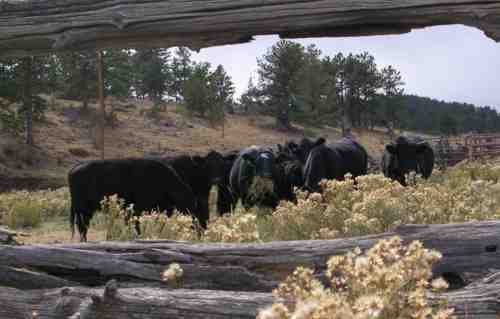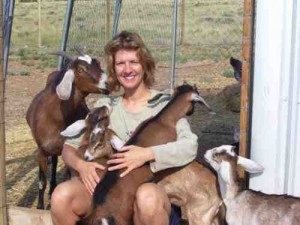Column by Hal Walter
Agriculture – January 2008 – Colorado Central Magazine
A CATTLE DRIVE in the New West isn’t exactly like Lonesome Dove. For starters, it’s not as romantic. And though there are some perils, it’s nowhere near as dangerous.
Moreover, time is now measured in hours rather than days, weeks, or even months. Horses and mules have given way to heavy-duty pickup trucks and gooseneck stock trailers. And historic routes such as the Goodnight-Loving Trail have been lost to state and federal highways. In short, what used to be the adventure of a lifetime has been reduced to merely a stressful day in the life of the modern-day cosmic cowboy.
One of my part-time jobs is managing a small ranch. It’s a conglomerate of contiguous properties that includes about 200 acres of private land and a 640-acre State Land Board “school section” lease. When I started the job three years ago, I urged the owners to get into the natural grassfed beef business, and arranged to purchase the best clean cattle I could find locally, starting with fourteen head — nine cows and heifers, and five calves. We don’t use any drugs, hormones, or feed our cattle any grain, so they’re about as natural as natural gets.
One of our biggest problems is that the school section pasture, at nearly 9,000 feet altitude, does not support life in wintertime. When the cold weather hits, our springwater troughs morph into miniature glaciers almost overnight. What was a gently sloping bovine paradise of blue gramma grass meadows and lush bottomlands becomes a vast frozen wasteland.

That’s when we move the entire herd 4,000 feet lower to Avondale, just east of Pueblo. Our partner in this enterprise, Doug Wiley, keeps them there for the winter at his Larga Vista Ranch. In the spring, after the calves are born, I haul them back to the mountains.
We’re building the herd from the original fourteen head. Over the years we’ve culled some animals, lost a few to various causes — including lightning, predation, and illness — and spun some steers off into Doug’s meat program. But slowly, the herd has grown to 23 head — nine cows, five heifers, eight calves, and one bull. We know we won’t make any money until we have three times this many animals, but even now it’s not an insignificant number of critters to feed, manage, and transport.
The old guy I bought the original herd from passed away last year. He was always adamant I get the animals out of the high country by Hallowe’en. He told me his own horror stories of trying to keep cattle up here during the cold months, including losing one cow in a snow-filled cattleguard. But this year with the long, warm La Niña fall, I decided to save some expense by holding them on the mountain pasture a little longer. The forage, though dry, was still quite abundant, and one neighbor even opened the fence to an adjacent small pasture that she wanted grazed.
Just in case, I put a 1,100-pound bale of hay in the school section catch corral and then closed the gates. My plan being that if it snowed for real, I could open the gates and the cattle would be both fed and caught. I also bought some small bales and stacked them nearby to supplement the pasture and to keep the animals visiting the corral regularly. Cold nights also meant breaking ice on the stock tank and fishing it out with a pitchfork.
My daily schedule is complicated, to say the least, with three part-time jobs and a 3-year-old son. So setting aside a full day to move cattle was a challenge, much less finding one with warm weather and dry roads. Finding that same day when I could con someone into helping me was even more impossible. Before I knew it, Hallowe’en had long passed, Thanksgiving too, and I was staring Christmas in the face with cattle still on the mountain pasture.
EARLY IN THE FIRST WEEK OF December, the weather service website forecast a warm day. Better yet, my friend and neighbor Amy Finger said she’d help me move the cattle. Two days before the predicted warm spell, I opened the catch-pen gates and the cattle were attracted to the hay. I chased them out later that day and then did the same drill the next day. The balmy morning of the cattle drive I opened the corral and shut the gates behind them.
The first year we moved the cattle off the mountain, the old guy hauled them for me and they all fit in his trailer; we had them loaded in about 15 minutes flat. The next year it took three trailers and about an hour.
Clearly Amy and I were not getting all of the cattle out of here in two trailers. I had decided to move all the cows and calves, and to leave the heifers and bull for the next warm day. For safety, I prefer to haul the cows separately from the calves to prevent the smaller animals from getting stepped on or crushed during the trip. I decided to load four cows in the front of my trailer, and four calves in the rear. Amy, with a diesel truck and a longer trailer, could haul five cows and four calves.
But sorting and loading the cattle proved to be even more difficult this year, with 23 animals in the rickety old wooden corral, and the makeshift loading chute that I’ve pieced together from old steel corral panels. Getting the cows and calves separated from the bull and heifers was nearly impossible. After several attempts, we finally managed to get four cows and four calves into the chute and to get the first trailer loaded. But one of the cows got separated from her calf and she was snorting and kicking at us whenever she got the chance.
I pulled my rig out and Amy backed hers to the chute. We were lucky to corner a couple of the heifers and send them out of the corral. But the rest of the cattle were getting nervous and bunching up. It took some work, and actually the help of our friend April who just happened by, to finally get the other cows and calves separated and loaded, and to not get kicked by the angry cow in the process. When we finally headed down the road we were two hours behind schedule.
Hauling cattle with trucks and trailers obviously isn’t as difficult or slow as herding them cross-country with horses, but it’s not exactly cruising down the highway in a luxury SUV either. The first leg of the journey drops 3,000 vertical feet in 15 miles, most of the steep descent being in the curvy Hardscrabble Canyon. My truck has an automatic transmission; I gear down to first in the steeper sections but must still carefully feather the brakes all the way down to keep the rig from taking off on me and putting about $20,000 worth of artisan beef over the side. Amy has a manual transmission, which holds the load back with the engine and minimal braking. Either way, the first few miles pass rather slowly.
ON THE OPEN HIGHWAY FROM Wetmore to Pueblo we were able to get into the 50 mph range. In my sideview mirror I could see our biggest cow, Sophie, stick her huge head up to test the air, the warm wind rushing between her big ears. She’s a ridiculous behemoth animal, a Maine-Anjou weighing more than 1,600 pounds. Whenever she moved, the entire truck and trailer shifted. On an uphill stretch near Pueblo Dam, my truck strained to top 40 mph pulling a load that I figured to be nearly 10,000 pounds, including the trailer.
I did not fail to notice the irony as we drove past the old stone Goodnight barn, located in a former gravel pit below Pueblo Dam. According to various historical sources, Charles Goodnight was the Texas cattleman whose life is said to have provided the loose framework for the book and movie “Lonesome Dove.” The former Texas Ranger drove thousands of longhorn-cross cattle from Texas north to New Mexico, Colorado and Wyoming. In the 1870s he settled at Rock Canyon Ranch along the Arkansas River just west of Pueblo where the stone barn still stands. He later established another large ranch in the Texas Panhandle, and died in 1929 at 93.
Goodnight might be startled by the tricky nature of urban livestock hauling, but Pueblo motorists seem to understand that a truck, stock trailer, and 7,000 pounds of cattle is something to give a wide berth. Amy and I were hungry. Instead of waiting for a chuckwagon, which Goodnight is reported to have invented, I knew a place to get something quick. We stopped at Adolpho’s on the edge of the lower East Side neighborhood. Conveniently there was dirt parking alongside the Fountain Creek levy. The cows and calves mooed and bawled while we ordered tostados and tacos to go.
Then we were back on the road, through the East Side, onto U.S. 50, past the airport industrial park, the Pueblo Chemical Depot and on to Avondale, where at last we unloaded the cattle.
There’s no way to describe how light the trailer feels when you drive it away empty. We hadn’t had to camp out, endure foul weather, raids, or even hunger, but still it had been a long day and we’d be getting home well after dark.
Winter weather arrived again shortly after our cattle drive. I’d like to move the bull and five heifers soon and am hoping for another warm winter day. Until then, I’ll be breaking ice and bucking hay. Old West or New, I’ve heard it said this type of work is never done.
Hal Walter raises burros when he’s not chasing cows or constructing prose in the Wet Mountains of Custer County.


